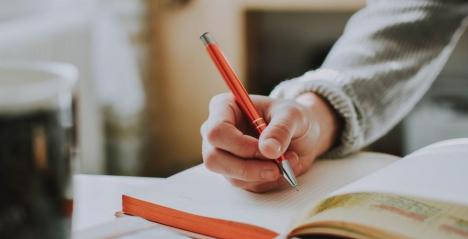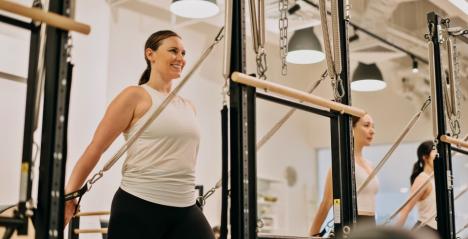Pilates, widely recognised for its numerous health benefits, is often associated with improved flexibility, core strength, and overall body toning. However, many wonder if Pilates can truly help build muscle mass.
In this article, we will delve into the relationship between Pilates and muscle development, exploring the targeted muscle groups, potential gains, physical and mental benefits, effective Pilates exercises for muscle building, the role of Pilates in weight loss, and the additional benefits of Reformer Pilates.
Does Pilates Help Build Muscle?
Pilates can help with muscle gain.
While it may not be as focused on muscle hypertrophy as weightlifting or resistance training, Pilates exercises can still provide resistance and challenge your muscles, leading to increased strength and tone.
Pilates focuses on engaging the deep stabilising muscles and developing a strong core, which can support and enhance overall muscle development. By targeting specific muscle groups through controlled movements and proper form, Pilates can help build lean muscle mass and improve overall body strength.
Additionally, it emphasises body awareness, alignment, and control, which can enhance muscle activation and coordination during exercises.
To optimise muscle gain, it's important to incorporate progressive resistance, challenge your muscles with different Pilates exercises, and continually progress in difficulty or intensity.
What Muscle Groups are Targeted Through Pilates?
Pilates is renowned for its ability to engage and strengthen various muscle groups throughout the body. While the focus is predominantly on the core muscles, Pilates exercises also target other major muscle groups. Here are some of the key muscle groups targeted through Pilates:
Core Muscles:
Pilates places a strong emphasis on strengthening the core muscles, including the deep abdominal muscles (transversus abdominis), the obliques, and the muscles of the lower back (erector spinae). These muscles provide stability and support to the spine and pelvis.
Glutes:
Pilates exercises involve activating and strengthening the gluteal muscles, including the gluteus maximus, gluteus medius, and gluteus minimus. Strong glutes are essential for hip stability, posture, and overall lower body strength.
Legs:
Pilates incorporates movements that target the muscles of the legs, including the quadriceps, hamstrings, and calves. Exercises like leg presses, lunges, and leg circles engage these muscle groups, improving leg strength and flexibility.
Arms and Shoulders:
Pilates exercises also engage the muscles of the upper body, including the arms and shoulders. Movements like push-ups, tricep dips, and arm circles strengthen the biceps, triceps, deltoids, and other supporting muscles in the upper body.
Back Muscles:
Pilates promotes a strong and stable back by targeting the muscles of the upper, mid, and lower back. Strengthening exercises like the swimming exercise, back extension, and rowing motions engage the muscles along the spine, promoting proper posture and reducing back pain.
Pelvic Floor Muscles:
Pilates places importance on engaging and strengthening the pelvic floor muscles, which play a vital role in supporting the pelvic organs and maintaining urinary control.

How Much Muscle Mass Can I Expect to Gain?
While Pilates may not lead to substantial muscle mass gains like traditional weightlifting, it can still promote lean muscle development. The resistance provided by the bodyweight exercises and the use of Pilates equipment help to tone and strengthen muscles, creating a more sculpted appearance. The extent of muscle gain varies depending on factors such as individual fitness level, consistency of practice, and proper nutrition.
The Benefits of Pilates: Physical and Mental Well-being
Engaging in regular Pilates practice offers numerous benefits beyond muscle development. Pilates enhances flexibility, improves posture, and increases overall body awareness. Moreover, it promotes a strong mind-body connection, reduces stress, and enhances mental well-being. The combination of physical and mental benefits makes Pilates a comprehensive approach to overall fitness and vitality.
Effective Pilates Exercises for Muscle Building
Pilates exercises can be effective for building muscle mass, especially when performed with proper form and progression. Here are a few Pilates exercises that target different muscle groups and can help in building muscle strength and tone:
1. Pilates Push-Up: This exercise primarily targets the chest, shoulders, and triceps. Start in a push-up position with your hands under your shoulders and legs extended. Lower your body down while maintaining a straight line from head to heels, and then push back up. Modify the exercise by bending your knees or performing it on an incline if needed.
2. Pilates Bridge: The Bridge exercise works the glutes, hamstrings, and lower back muscles. Lie on your back with your knees bent and feet flat on the floor. Lift your hips off the mat, creating a straight line from your knees to your shoulders. Squeeze your glutes at the top and lower back down.
3. Single Leg Circle: This exercise targets the hip abductors, hip flexors, and core muscles. Lie on your back with your legs extended. Lift one leg toward the ceiling and make circles in the air with your foot. Repeat in both clockwise and counterclockwise directions before switching legs.
4. Pilates Side Plank: This exercise challenges the obliques, shoulders, and core muscles. Start by lying on your side, supporting your body weight on one forearm, with your feet stacked on top of each other. Lift your hips off the mat, creating a straight line from head to heels. Hold for a few seconds and then lower back down. Repeat on both sides.
5. Pilates Teaser: The Teaser exercise engages the abdominals, hip flexors, and lower back muscles. Start by lying on your back with your legs extended and arms reaching overhead. Lift your legs and upper body off the mat simultaneously, reaching your arms towards your toes. Slowly lower back down with control.
Remember to always maintain proper form, breathe deeply, and engage your core throughout these exercises. It's important to start with appropriate modifications and progress gradually as your strength improves. Consulting with a qualified Pilates instructor can help ensure you're performing the exercises correctly and safely to maximise muscle-building benefits.

Is Pilates Effective for Weight Loss?
While Pilates primarily focuses on muscle strength and toning, it can contribute to weight loss indirectly. By increasing muscle mass, Pilates boosts metabolism, leading to a higher calorie burn even at rest. Additionally, Pilates can improve overall body composition, increasing lean muscle mass while reducing body fat percentage.
Reformer Pilates: Enhancing Muscle Building Potential
Reformer Pilates, a variation of Pilates that utilises a specialised machine called the Reformer, offers additional benefits for building muscle mass. The resistance provided by the Reformer's springs adds intensity to exercises, increasing the challenge and promoting muscle growth. Reformer Pilates can target specific muscle groups with more precision, allowing for progressive overload and further muscle development.
Conclusion
While Pilates may not be synonymous with bulking up, it undoubtedly plays a significant role in building lean muscle mass, improving overall strength, and promoting a toned physique. By targeting specific muscle groups, incorporating effective exercises, and embracing the mind-body connection, Pilates offers a unique approach to muscle development. Whether you're seeking to tone, strengthen, or sculpt your body, Pilates can be a valuable addition to your fitness routine, providing both physical and mental benefits that extend far beyond the weight room. Embrace the transformative power of Pilates and unlock your full muscular potential












